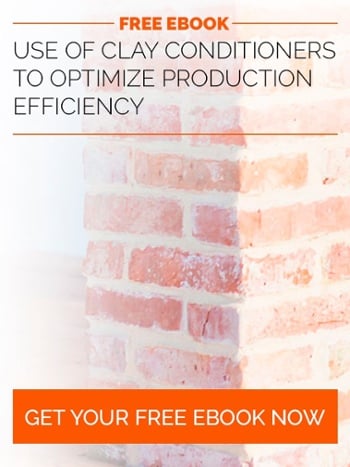
All brick and tile manufacturers strive for the elusive 100% yields, but in reality, the norm is anywhere from circa 50% upwards depending upon raw materials, products being produced and processes. These losses have been seen to occur in the extruding/moulding of the clay products, during the drying and firing processes and throughout all handling stages of production.
There are a number of different ways forward to try to increase yields:
- The use of more plastic clays.
Incurs time and money in searches for these clays, new body formulation and may be a change in the production process - Changes to the actual production process
Looking at the mechanics/moving parts within the extruder. Investigating the methods of release from moulds being used in soft mud, hand thrown, tile pressing - An increase in the addition of more non-plastic clays such as sands or grog to try and “open” up the clay body more
However, all the above options require increased resources, time and, to an extent, increased costs and have proven at times not to give the desired results.
Real life examples
Another alternative available to the manufacturer is the use of clay additives which have been shown to give positive results - almost straight away – when used in production. This comparison table a testament from a UK brick manufacturer:
|
Without clay conditioner |
With clay conditioner |
|
50m Bricks P.A. |
52m Bricks P.A. |
|
95% Facings |
97% Facings |
|
2% Cracking |
No Cracking |
|
2% Waste |
0.5% Waste |
|
20% Perforation |
25% Perforation |
|
Profit £900,000 |
Profit £1,050,000 |
As the factory production trials above show, the manufacturer was able to increase production by 4% and at the same time boost profitability by improving yields and increasing perforation.
Another manufacturer had contacted us to discuss his slow production rates and hightened losses after installing new driers and kilns. A clay conditioner was supplied and trialled, and the results were almost instantaneous, the factory’s production rates increased by 10% from 25000 bricks to 27500 bricks, and their cracking losses dropped from 60% to below 1%.
How clay conditioner works
The special trick of the clay conditioner is that it gives the internal clay body better lubrication to improve workability and formation. At the same time, it reduces extrusion friction. This results in better flow, reduced power requirements and smoother operations be it soft mud or extrusion. Furthermore, as water begins to evaporate from the article, the clay conditioner promotes an improved bond strength which in turn results in a faster strength gain. During the drying process, the additive increases the breaking strength of the clay mix. Being water soluble a significant amount of the clay conditioner will be carried to the surface. It will concentrate at the evaporation points forming a hard layer of material at these most vulnerable points (i.e. the edges). The resistance to damage in all aspects of handling improves, resulting in much-reduced losses and downgrading of products.
The impact on different clays
The table below highlights improvements in differing production and technical parameters against a range of clays commonly used in the manufacture of both clay bricks and tiles.
|
Parameters |
|||||||
|
Clay type and process |
Production rate |
Extruder amperage |
Power consumption |
Relative green strength |
Moisture content |
Dry strength |
Extruder efficiency |
|
Carboniferous shale – extruded |
+5.8% |
-15.6% |
-20.5% |
+9.0% |
-0.1% |
+11.8% |
+26.0% |
|
Carboniferous shales – extruded |
NIL |
-14.8% |
-14.3% |
+16.0% |
NIL |
+13.5% |
+16.7% |
|
Carboniferous shale-extruded/pressed |
NIL |
NIL |
NIL |
+28.3% |
-1.2% |
N/A |
+1.4% |
|
Carboniferous Ref U/Clay – extruded |
+9.9% |
-10.2% |
-17.8% |
+14.6% |
-0.6% |
N/A |
+22.6% |
|
Carboniferous Buff Fireclay – extruded |
+20.5% |
-5.0% |
-21.2% |
+21.2% |
-0.7% |
N/A |
+27.9% |
|
Devonian Shale –extruded |
+5.7% |
-13.7% |
-18.8% |
+13.0% |
-0.3% |
+33.3% |
+23.5% |
|
Keuper Marl –extruded |
+1.1% |
-7.8% |
-8.7% |
+24.6% |
-0.9% |
+20.3% |
+10.7% |
|
Brickearth – extruded and repressed |
+1.1% |
-21.2% |
-22.4% |
+26.2% |
-0.6% |
+23.8% |
+29.7% |
|
Etruria Marl – extruded |
+7.0% |
-15.5% |
-20.8% |
+23.9% |
-0.1% |
+16.4% |
+26.4% |
|
Non-clay refractory – extruded |
+13.7% |
-6.9% |
-17.4% |
+30.0% |
-0.5% |
N/A |
+21.5% |
|
Hastings beds – soft mud moulded |
NIL |
N/A |
N/A |
N/A |
-1.5% |
+113.3% |
N/A |
|
Weald clay – soft mud moulded |
NIL |
N/A |
N/A |
N/A |
-0.7% |
+35.3% |
N/A |
FREE E-BOOK:
USE OF CLAY CONDITIONERS TO OPTIMIZE PRODUCTION EFFICIENCY
DOWNLOAD NOW




